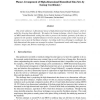Free Online Productivity Tools
i2Speak
i2Symbol
i2OCR
iTex2Img
iWeb2Print
iWeb2Shot
i2Type
iPdf2Split
iPdf2Merge
i2Bopomofo
i2Arabic
i2Style
i2Image
i2PDF
iLatex2Rtf
Sci2ools
CBMS
2003
IEEE
2003
IEEE
Planar Arrangement of High-Dimensional Biomedical Data Sets by Isomap Coordinates
This article addresses 2-dimensional layout of high-dimensional biomedical datasets, which is useful for browsing them efficiently. We employ the Isomap technique, which is based on classical MDS (multi-dimensional scaling) but seeks to preserve the intrinsic geometry of the data, as captured in the geodesic manifold distances between all pairs of data points while classical approaches can see just the Euclidean structure. According to first two of Isomap's coordinates, the high-dimensional data points are arranged in a plane. Experimental results with images of marine creatures' shapes and 3D bone renderings are presented.
| Added | 23 Aug 2010 |
| Updated | 23 Aug 2010 |
| Type | Conference |
| Year | 2003 |
| Where | CBMS |
| Authors | Ik Soo Lim, Pablo de Heras Ciechomski, Sofiane Sarni, Daniel Thalmann |
Comments (0)

